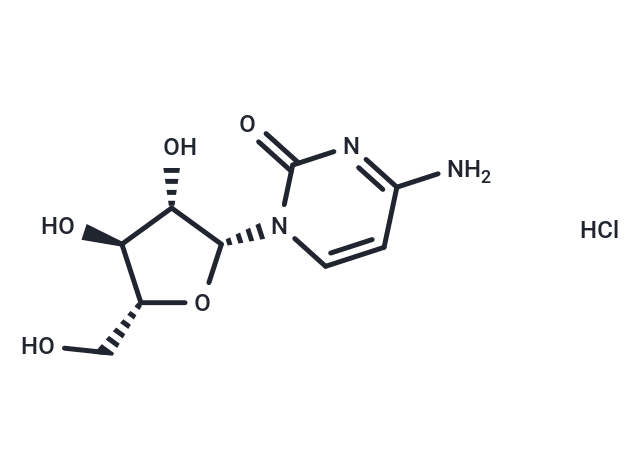Shopping Cart
Remove All Your shopping cart is currently empty
Your shopping cart is currently empty
Cytarabine hydrochloride (Ara-C hydrochloride) is a nucleoside analog that causes S phase cell cycle arrest and inhibits DNA polymerase. Cytarabine inhibits DNA synthesis with an IC 50 of 16 nM. Cytarabine hydrochloride has antiviral effects against HSV.

| Pack Size | Price | USA Warehouse | Global Warehouse | Quantity |
|---|---|---|---|---|
| 50 mg | $33 | In Stock | In Stock | |
| 100 mg | $47 | In Stock | In Stock | |
| 200 mg | $68 | In Stock | In Stock | |
| 500 mg | $112 | In Stock | In Stock | |
| 1 mL x 10 mM (in DMSO) | $52 | In Stock | In Stock |
| Description | Cytarabine hydrochloride (Ara-C hydrochloride) is a nucleoside analog that causes S phase cell cycle arrest and inhibits DNA polymerase. Cytarabine inhibits DNA synthesis with an IC 50 of 16 nM. Cytarabine hydrochloride has antiviral effects against HSV. |
| In vitro | Cytarabine is converted into its active form, Ara-CTP (tri-phosphate), by the enzyme deoxycytidine kinase (dCK). It then competes with the natural nucleotide dCTP for incorporation into DNA, ultimately inhibiting DNA synthesis by disrupting DNA and RNA polymerases' functions. This compound exhibits potent growth inhibitory effects on wild-type CCRF-CEM cells, with an IC50 of 16 nM, showcasing higher efficacy compared to other acute myelogenous leukemia (AML) cells. Moreover, Cytarabine is capable of inducing apoptosis in rat sympathetic neurons at a concentration of 10 μM, with the highest observed toxicity at 100 μM, resulting in over 80% cell death within 84 hours. This process involves the release of mitochondrial cytochrome-c and activation of caspase-3, with noted attenuation of toxicity via p53 knockdown and a delay through bax deletion. |
| In vivo | Cytarabine (250 mg/kg) induces placental growth retardation and elevates apoptosis of trophoblastic cells in the placental labyrinth zone in pregnant Slc:Wistar rats. This effect begins 3 hours post-treatment, peaks at 6 hours, and reverts to baseline at 48 hours. It notably increases p53 protein levels and the expression of p53 transcriptional target genes, such as p21, cyclinG1, fas, and activates caspase-3 [3]. Additionally, Cytarabine effectively combats acute leukemias by causing a characteristic G1/S phase block and cell synchronization, thereby extending the survival of leukemic Brown Norway rats. Its effectiveness shows a weak dose-related pattern, suggesting that higher doses do not enhance its anti-leukemic effect in humans [4]. |
| Synonyms | Cytosine Arabinoside hydrochloride, Ara-C hydrochloride |
| Molecular Weight | 279.68 |
| Formula | C9H14ClN3O5 |
| Cas No. | 69-74-9 |
| Smiles | O[C@@H]1[C@@H](O[C@H](CO)[C@H]1O)N2C(=O)N=C(N)C=C2.Cl |
| Relative Density. | no data available |
| Color | White |
| Appearance | Solid |
| Storage | Powder: -20°C for 3 years | In solvent: -80°C for 1 year | Shipping with blue ice/Shipping at ambient temperature. | |||||||||||||||||||||||||||||||||||
| Solubility Information | DMSO: 50 mg/mL (178.78 mM), Sonication is recommended. | |||||||||||||||||||||||||||||||||||
| In Vivo Formulation | 10% DMSO+40% PEG300+5% Tween 80+45% Saline: 2 mg/mL (7.15 mM), Sonication is recommended. Please add the solvents sequentially, clarifying the solution as much as possible before adding the next one. Dissolve by heating and/or sonication if necessary. Working solution is recommended to be prepared and used immediately. The formulation provided above is for reference purposes only. In vivo formulations may vary and should be modified based on specific experimental conditions. | |||||||||||||||||||||||||||||||||||
Solution Preparation Table | ||||||||||||||||||||||||||||||||||||
DMSO
| ||||||||||||||||||||||||||||||||||||
| Size | Quantity | Unit Price | Amount | Operation |
|---|

Copyright © 2015-2026 TargetMol Chemicals Inc. All Rights Reserved.